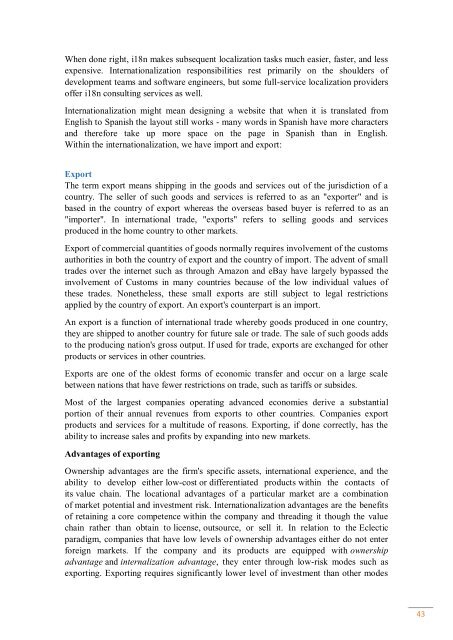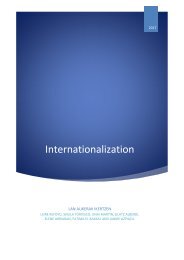TXOSTENA1
Create successful ePaper yourself
Turn your PDF publications into a flip-book with our unique Google optimized e-Paper software.
When done right, i18n makes subsequent localization tasks much easier, faster, and less<br />
expensive. Internationalization responsibilities rest primarily on the shoulders of<br />
development teams and software engineers, but some full-service localization providers<br />
offer i18n consulting services as well.<br />
Internationalization might mean designing a website that when it is translated from<br />
English to Spanish the layout still works - many words in Spanish have more characters<br />
and therefore take up more space on the page in Spanish than in English.<br />
Within the internationalization, we have import and export:<br />
Export<br />
The term export means shipping in the goods and services out of the jurisdiction of a<br />
country. The seller of such goods and services is referred to as an "exporter" and is<br />
based in the country of export whereas the overseas based buyer is referred to as an<br />
"importer". In international trade, "exports" refers to selling goods and services<br />
produced in the home country to other markets.<br />
Export of commercial quantities of goods normally requires involvement of the customs<br />
authorities in both the country of export and the country of import. The advent of small<br />
trades over the internet such as through Amazon and eBay have largely bypassed the<br />
involvement of Customs in many countries because of the low individual values of<br />
these trades. Nonetheless, these small exports are still subject to legal restrictions<br />
applied by the country of export. An export's counterpart is an import.<br />
An export is a function of international trade whereby goods produced in one country,<br />
they are shipped to another country for future sale or trade. The sale of such goods adds<br />
to the producing nation's gross output. If used for trade, exports are exchanged for other<br />
products or services in other countries.<br />
Exports are one of the oldest forms of economic transfer and occur on a large scale<br />
between nations that have fewer restrictions on trade, such as tariffs or subsides.<br />
Most of the largest companies operating advanced economies derive a substantial<br />
portion of their annual revenues from exports to other countries. Companies export<br />
products and services for a multitude of reasons. Exporting, if done correctly, has the<br />
ability to increase sales and profits by expanding into new markets.<br />
Advantages of exporting<br />
Ownership advantages are the firm's specific assets, international experience, and the<br />
ability to develop either low-cost or differentiated products within the contacts of<br />
its value chain. The locational advantages of a particular market are a combination<br />
of market potential and investment risk. Internationalization advantages are the benefits<br />
of retaining a core competence within the company and threading it though the value<br />
chain rather than obtain to license, outsource, or sell it. In relation to the Eclectic<br />
paradigm, companies that have low levels of ownership advantages either do not enter<br />
foreign markets. If the company and its products are equipped with ownership<br />
advantage and internalization advantage, they enter through low-risk modes such as<br />
exporting. Exporting requires significantly lower level of investment than other modes<br />
43








